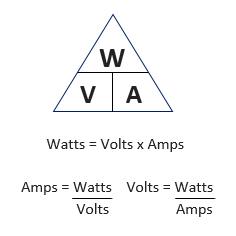Difference between watts and volt-amps for UPS systems

Uninterruptible Power Supply (UPS) systems are often integrated into electrical grids to minimize the risk of power failures. Present in a multitude of locations, unique UPS systems are designed to best suit specific industries. For example, military specification UPS systems (MIL-SPEC) are used in military circumstances, while industrial UPS systems are best for industrial or manufacturing industries.
Perhaps unlike your first impression, identifying the category of UPS system that best suits your industry is not entirely confusing, as most systems are appropriately named after the industries for which they are designed. Visit also: APC Smart UPS
On the other hand, selecting the best UPS system for your needs should begin with understanding the technical terms found in UPS systems, specifically volt-amps and watts.
In the content below, we explore the difference between these two electrical measurement methods, especially when it comes to UPS systems. Let’s dive in.
What are volt-amps?
Volt-amps (VA) is a measure of “apparent” electrical power, calculated by multiplying voltage (volts) by amperage (amps). To understand VA we need to define volts and amps individually.
Volts represent the speed at which electrons pass through a specific point in a closed circuit.
Amps complement volts. An amplifier measures the volume (and not the speed) of the electrons present in an electrical circuit.
Therefore, VAs are calculated by the volume of electrons present in an electrical circuit time the speed at which electrons move in the circuit. VA measures “apparent” electrical power – the power that will be used once the current has been used.
What are watts?
Although the term is quite different, watts are identified in the same way as volt amps (V x A = W). With regard to UPS systems, are VA and watts interchangeable then? While that may simplify things, the answer is no. Watts and VA are calculated using the same formula, but they measure different factors.
VA measures “apparent” power, while watts measure “real power” generated in the electrical circuit.
Ultimately, a device that requires 5 amps and 100 volts would have a power rating of 500 watts or 500 volt-amps.
And ohms?
Another commonly confused technical term is the ohm. However, it is beyond the scope of this piece to define and explore. If you’re interested in a deeper dive, we often refer to a great resource comparing amps, volts, watts, and ohms written by one of our UPS OEM partners. The blog referenced is a concise description of these misunderstood electrical terms, and we recommend the resource.
Inverter rating volt-ampere
UPS systems rarely, if ever, mention watts. The term “volt-amps” is much more common, so we’ll start there.
VAs are especially used when examining AC circuits because these circuits have inductive resistance. Inductive resistance is complex and calculating the number of volt-amps required to operate all devices in a specific circuit may require the help of a specialist.
Also, the output capacity of a UPS system is determined by its output current. Volt-amps more accurately describe output current than watts.
Inverter rated power
When an inverter manufacturer uses power ratings for an inverter system, they often (incorrectly) use watts as another term for volt amps. Some manufacturers rate their systems in volt-amps and watts to avoid confusion.
Watts are most often used when DC circuits are taken into account since DC circuits are pure resistance and watts measure “true power.” To calculate the power required for a circuit to function properly, simply add up all the watts needed to operate individual devices on that circuit. For example, if your circuit contains 3 devices, each rated at 400 watts, you would need 1200 watts of power to run the entire system.
The advantage of knowing the VA value of your UPS system
The most obvious benefit of knowing the VA value of your chosen UPS system is ensuring that the system will be able to handle your electrical needs in the event of a power outage.
Also, knowing the VA value of your UPS system will avoid overloading the system. Even if power is not removed from your facility, your inverter may overload. Which can result in damage to internal components and a risk of fire.
How do you know if you are overloading your investor?
First, select a unit that can easily meet your needs. Your base load should not exceed 50% of the UPS capacity; If the load has reached 60%, it is time to upgrade your UPS to better meet your needs. For example, if your system requires 700 VA to operate. We recommend that you purchase a UPS with a power rating of at least 1400 VA.
For details, please visit: https://www.multilinkeng.com





